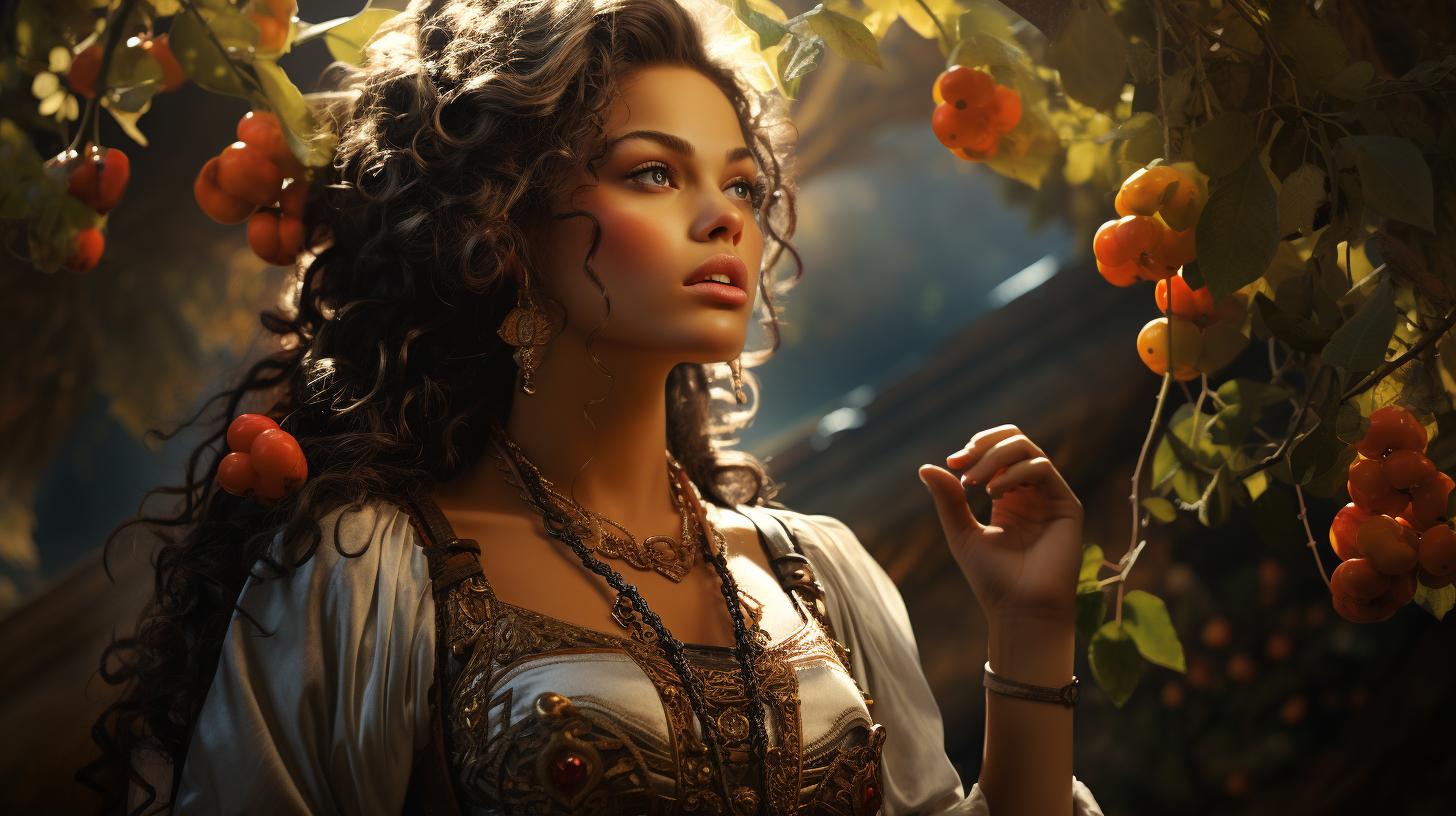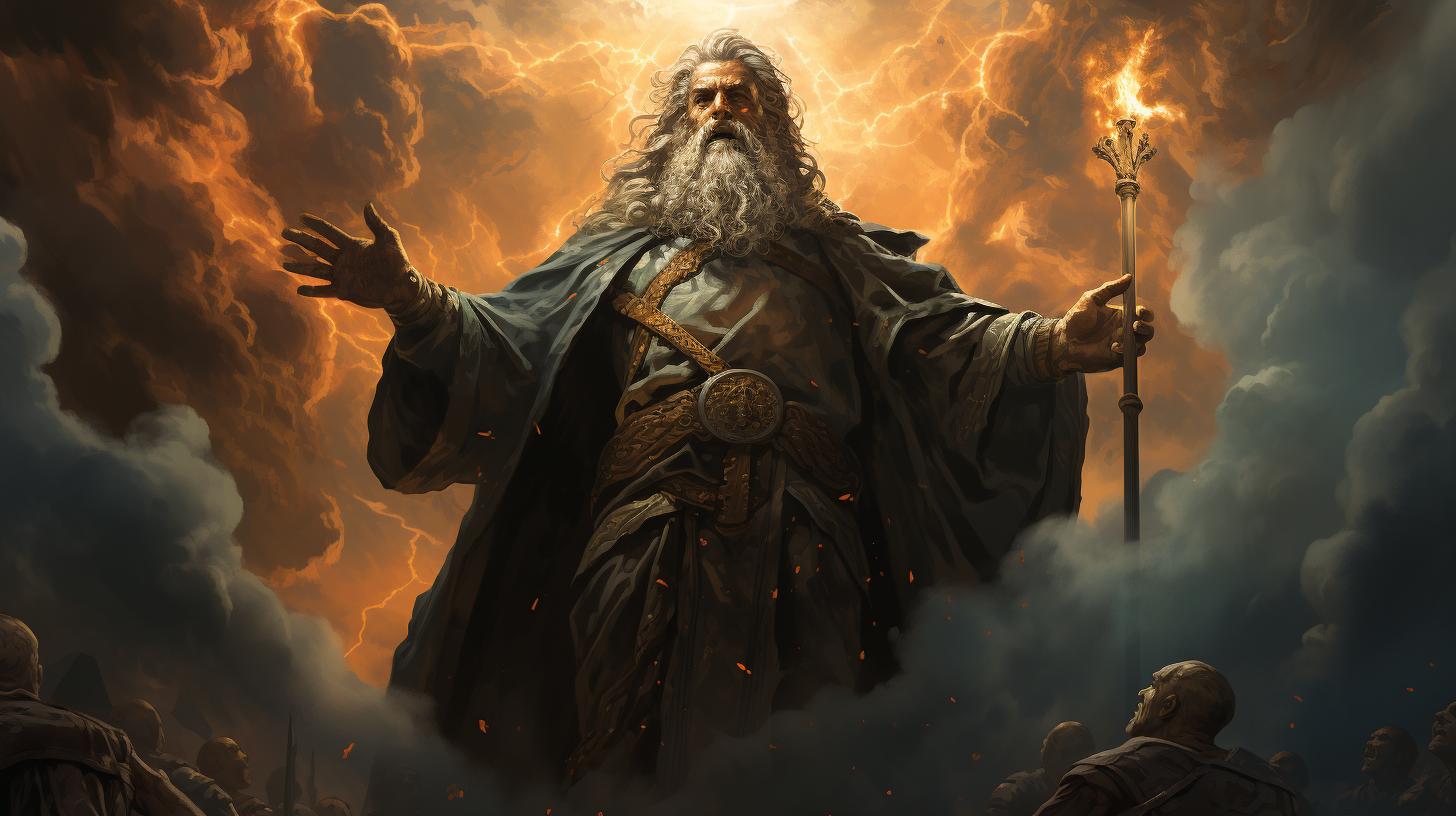Goddess Nikkal: Unveiling the Divine Power and Fertility of Ancient Mesopotamian Deity

The ancient Mesopotamian deity Nikkal, worshipped in various regions of the ancient Near East, holds a prominent position in different cultures’ religious beliefs. This article explores Nikkal’s origins, associations, and role in Hurrian, Ugaritic, and Hittite texts.
It also examines Nikkal’s symbolism as the goddess of fruits and fertility, her depictions in art and iconography, and her relationship with the moon god Yarikh. Additionally, the worship and cult surrounding Nikkal, her presence in Canaan, Phoenicia, Ugarit, and her significance in Hurrian and Turkish mythologies are discussed.
Recent archaeological discoveries and ongoing research shed light on Nikkal’s enduring influence.
The Ancient Mesopotamian Deity Nikkal
As we delve into the rich tapestry of ancient Mesopotamian religious beliefs, we encounter the captivating figure of Goddess Nikkal. This enigmatic deity holds immense significance in the diverse cultures of the region, leaving an indelible mark on Mesopotamian, Hurrian, and Hittite myths and rituals.
Origins and Associations
The origins of Nikkal’s divine lineage are shrouded in mystery, with scholars positing various theories. While some suggest her father as the deity ḫrḫb, explicit references to this connection remain elusive.
Nonetheless, Nikkal assumes a prominent position in the Hurrian pantheon and receives veneration in the Kingdom of Kizzuwatna, the Hittite Empire, and Ugarit. It is believed that she might have been introduced to the Hittite pantheon by Queen Nikkal-mati, the wife of Tudḫaliya I.
Nikkal in Hurrian and Ugaritic Texts
Within the texts of the Hurrians, Nikkal is often mentioned alongside the Moon God under the names Kušuḫ and Umbu. This celestial pairing symbolizes the divine union of lunar and feminine energies, embodying the delicate balance between the changing lunar phases and the fertility of the earth.
In the city of Ugarit, Nikkal finds her place alongside Kušuḫ as the wife of the local Moon God, Yarikh.
Nikkal’s Role in the Hittite Religion
The Hittites also recognize the influence of Nikkal, attributing her importance to the realm of agricultural abundance and fertility. Within Hittite religious texts, Nikkal appears in ritualistic contexts, offerings lists, and theophoric names.
Her representation can be witnessed at the sanctuary of Yazılıkaya, and she is included in processions of deities, highlighting her esteemed position within the pantheon.
Though references to Nikkal’s reception in Ugarit are brief and lack substantial details, her existence in this cultural context affirms her enduring presence and significance throughout the ancient Near East.
The Symbolism and Representations of Goddess Nikkal
Nikkal as the Goddess of Fruits and Fertility
Goddess Nikkal holds a significant role as the embodiment of abundance and fertility, specifically in relation to fruits and agricultural prosperity. Revered in ancient Mesopotamian and Canaanite cultures, Nikkal is viewed as the provider of bountiful harvests and the protector of orchards.
Her name, derived from the ancient West Semitic word ‘Ilat ‘Inbi’, directly translates to ‘Goddess of Fruits’, emphasizing her association with the cultivation and flourishing of crops.
She is closely linked to the seasonal cycles and the agricultural calendar, where her presence is believed to ensure the successful growth and ripening of fruits. Nikkal’s influence extends beyond mere sustenance, as she represents the life-giving force of the earth and the continual renewal of nature.
Devotees offer rituals and prayers to honor her, seeking her favor for bumper crops and prosperous yields.
Depictions of Nikkal in Art and Iconography
Throughout ancient Mesopotamia and Canaan, Nikkal was frequently depicted in art and iconography. Artists often portrayed her as a regal figure clad in elaborate attire, symbolizing her status as a divine being.
In these representations, she is shown holding various fruits, such as dates, olives, figs, and apples, highlighting her association with agricultural abundance.
Sculptures and reliefs found in temples and sanctuaries depict Nikkal in a serene and nurturing manner. Her presence amidst flourishing trees, such as the date palm, olive, and fig, signifies the deep connection between her divine energy and the prosperous growth of orchards.
These artistic depictions serve as a visual testament to the veneration and reverence accorded to Nikkal in ancient societies.
Nikkal’s Relationship with the Moon God Yarikh
One of the prominent aspects of Nikkal’s symbolism lies in her association with the moon god Yarikh. In the ancient Near East, the moon was often considered a symbol of fertility and growth, and Nikkal served as the consort of Yarikh, the moon god who brings forth dew and nourishes the trees.
This celestial union between Nikkal and Yarikh signifies the harmonious balance between lunar influences and the fertility of the earth.
Their divine relationship represents the essential interplay between the celestial and earthly realms, emphasizing the role of Nikkal as a mediator between the heavens and the agricultural prosperity experienced on earth.
This connection between Nikkal and Yarikh signifies the divine forces at work in the natural world and underscores the importance of the lunar cycle in the agricultural calendar.
Worship and Cult of Goddess Nikkal
The worship and cult of Goddess Nikkal were central to the religious practices of various ancient Near Eastern cultures.
Devotees honored Nikkal through rituals, offerings, and the establishment of temples and sanctuaries dedicated to her. Additionally, festivals and celebrations were held to commemorate and express reverence for the goddess of fruits and fertility.
Rituals and Offerings to Honor Nikkal
Rituals were conducted as a means to connect with and show devotion to Goddess Nikkal. These ceremonies often involved prayers, chants, and the offering of symbolic items such as fruits, flowers, and incense.
The rituals aimed to invoke Nikkal’s blessings for fertility, agricultural abundance, and the nurturing of the land.
Alongside the rituals, devotees presented offerings to honor Nikkal. These offerings varied depending on the region, but commonly included fruits and agricultural produce, as well as precious materials like gold and silver.
The intent was to express gratitude and seek Nikkal’s favor for bountiful harvests and prosperity.
Temples and Sanctuaries Dedicated to Nikkal
Temples and sanctuaries were constructed in various ancient cities to serve as dedicated spaces for the worship and veneration of Goddess Nikkal. These sacred structures were adorned with elaborate artwork and symbols representing Nikkal’s associations with fertility, fruits, and the moon.
The temples housed statues or reliefs of Nikkal, often depicted in regal attire with attributes related to fertility, such as agricultural tools or symbols of abundance. The faithful visited these sanctuaries to offer prayers and participate in rituals led by priests and priestesses, seeking Nikkal’s blessings for their communities and personal lives.
Festivals and Celebrations Associated with Nikkal
Festivals and celebrations held in honor of Goddess Nikkal were vital communal events that brought people together to express their devotion and joy. These occasions occurred seasonally, aligning with significant agricultural milestones and cycles.
During these festivals, vibrant processions took place, accompanied by music, dances, and feasts. Participants adorned themselves with colorful costumes and accessories, reflecting the lively spirit of the celebrations. The festivities showcased the close connection between Nikkal, bountiful harvests, and the renewal of life, emphasizing the importance of her role in sustaining the well-being of the community.
- Offerings to Nikkal included fruits, flowers, and incense
- Temples dedicated to Nikkal adorned with artwork representing fertility
- Festivals marked by processions, music, dances, and feasts
Nikkal in Different Cultures of the Ancient Near East
In addition to her presence in Mesopotamia, the goddess Nikkal also held significance in various cultures across the ancient Near East.
Let’s delve into her role in Canaan, Phoenicia, Ugarit, Hurrian mythology, and Turkish mythology.
Nikkal’s Presence in Canaan, Phoenicia, and Ugarit
Canaan, Phoenicia, and Ugarit were regions where the worship of Nikkal thrived. In Canaanite mythology, she was revered as the goddess of fruits and fertility, playing a vital role in agricultural abundance.
The people of Phoenicia also associated her with the flourishing of orchards and the bountiful harvest. Nikkal’s presence in Ugarit was closely intertwined with the lunar deity Yarikh, being considered his wife.
Together, they symbolized the cyclic nature of the moon and its impact on fertility.
Nikkal’s Importance in Hurrian Mythology
In the religious beliefs of the Hurrians, Nikkal held a prominent position. She was revered as the wife of the lunar god Kušuḫ, associated with fertility and abundance. Nikkal’s role as the goddess of fruits in Hurrian mythology further emphasized her connection to the natural world and agricultural prosperity.
Her significance can be seen in Hurrian rituals and offerings, where she was invoked to ensure fruitful harvests and the well-being of the community.
Nikkal’s Significance in Turkish Mythology
In Turkish mythology, Nikkal was deeply revered as a goddess associated with the earth, agriculture, and fertility. She was believed to oversee the success of agricultural activities, the arrival of spring, and the growth of plants.
Nikkal’s role in Turkish culture echoes her importance as a figure bringing fertility and abundance to the land. Her worship and veneration continued to be practiced, highlighting the enduring relevance of her divine influence.
Exploring the presence and significance of the goddess Nikkal in diverse ancient Near Eastern cultures offers insights into the shared religious beliefs and interconnectedness of these civilizations. Understanding her role in Canaan, Phoenicia, Ugarit, Hurrian mythology, and Turkish mythology provides a deeper appreciation of her divine attributes and the impact of her worship on the communities that revered her.
Recent Discoveries and Research on Goddess Nikkal
Recent excavations and ongoing archaeological research have shed new light on the ancient Mesopotamian deity Nikkal and her influence in different cultures of the ancient Near East. Scholars have unearthed fascinating evidence that deepens our understanding of Nikkal’s significance and worship practices.
Excavations and Archaeological Evidence
Excavations at various ancient sites have uncovered artifacts, inscriptions, and temples dedicated to Nikkal, providing valuable insights into her cult and religious practices. Archaeologists have found statues representing Nikkal in temples and sanctuaries, emphasizing her importance in the daily lives of ancient communities.
Additionally, archaeological evidence reveals the presence of votive offerings, including fruit-related items, suggesting that Nikkal’s association with fertility and agriculture was central to her worship. Moreover, the discovery of textual sources and tablets has allowed scholars to decipher rituals, prayers, and hymns dedicated to Nikkal, providing further context to her religious significance.
Interpretations and Insights from Scholarly Works
Building upon the excavations, scholars and researchers have offered interpretations and insights into Nikkal’s role and symbolism within the ancient Mesopotamian pantheon. Through comparative analysis of myths and religious texts, they have identified connections between Nikkal and other deities, such as Ningal and Nin-Gal, further illuminating her divine associations.
Furthermore, scholarly works have explored Nikkal’s representation in art and iconography, examining the symbolism behind her depictions with fruit trees and linking her imagery to concepts of fertility and abundance. These studies deepen our appreciation for Nikkal’s multifaceted role and cultural significance in the ancient Near East.
Contemporary Relevance of Nikkal’s Worship and Influence
Although Nikkal’s worship originated in ancient times, her influence continues to resonate in contemporary culture. The revitalization of interest in ancient religions and spirituality has led to renewed appreciation and study of Nikkal’s role in the modern era.
Nikkal’s association with fertility and abundance remains relevant in agricultural communities and celebrations, where offerings and rituals are dedicated to ensure fruitful harvests. Additionally, artistic representations and depictions of Nikkal serve as a source of inspiration for contemporary artists, bridging the gap between past and present.
In summary, ongoing excavations, interpretations from scholarly works, and the enduring relevance of Nikkal’s worship offer fascinating insights into the ancient Mesopotamian deity. Discoveries continue to expand our knowledge of her significance, shedding light on the cultural and religious practices of the ancient Near East.
.




















